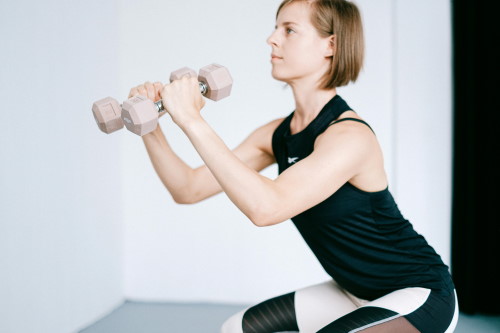You don’t need to let sore muscles get you down. After putting yourself through the paces, try these surprising recovery hacks for sore muscles.
What Is DOMS?
If you work out, sore muscles are likely part of the package. When you train hard, your muscles tend to become a bit tender over the following few days. This is a normal (and often welcome) part of the muscle-building process.
BREAKING: Viagra Obsolete: New Invention Cheaper, Safer, Faster
Why do your muscles get sore? When you train your body with resistance, like weights, and you push your muscles to perform better than they did the previous workout, you’re probably going to end up with some sore muscles.
There are two basic types of muscle soreness. One is “acute” soreness, which you feel right after your workout and is due to a buildup of substances like lactic acid. This type of soreness usually goes away within a few hours after exercise.
The other type of muscle soreness is called “delayed onset muscle soreness” (DOMS). It’s caused by the tearing down of muscle tissue during training sessions. This is how new, stronger muscle tissue is built and is a normal and necessary part of the process. DOMS usually does not set in until 12 – 24 hours after your workout has been completed and can sometimes be quite painful.
Why You Need to Prioritize Recovery
Recovering from your workouts is essential if you want to feel good and make progress toward your fitness goals. You can’t expect your body to constantly be in “go” mode. It needs time to rest, heal, and rejuvenate before you tear your muscles down again in the gym. While a little soreness is good and can even be a sign of a productive workout, pain and lingering soreness that lasts more than a few days is taking it too far. Learn to balance your tough exercise regimens with proper recovery techniques for maximum effect.
The Usual Sore Muscle Remedies
You’ve undoubtedly heard of many ways to deal with muscle soreness and recovery, including some of these:
- Get plenty of quality sleep—yes, recovery time is key. Naps can count, too, toward your quality sleep recovery time.
- Post-workout nutrition—make sure to get in a good quality protein meal within an hour of your workout to provide your body with the necessary components for muscle repair.
- Get quality nutrition throughout the day—this can include pre- and post-workout carbs as well to fuel your exercise and boost repair.
- Stay hydrated—drinking plenty of water will help keep your muscles limber and flush out excess waste products produced during exercise.
- Stretch—stretching during and after your training sessions can also help lessen the soreness you might encounter. Stretching facilitates blood flow, which helps remove the buildup of lactic acid and deliver healing nutrients to your muscles, so they can begin the repair process.
- Foam roll—this helps work out the kinks and bring blood flow to the area.
- Take time off—yes, sometimes you just need to take some downtime from the gym to allow your body to fully recover before hitting it hard again.
But those are just the usual methods of dealing with sore muscles.
Add Some Surprising Recovery Hacks for Sore Muscles
When you’re ready to branch out from the same old same old, give these recovery hacks for sore muscles a try:
- Start with a good warm-up—believe it or not, post-workout healing begins with how you start your exercise program. Giving muscles a chance to warm up gently and get your circulation going can ensure you’re working more flexible and limber muscles, causing less damage and, ultimately, less soreness.
- Cool down—how sore you get can also boil down to how you end your workout (although more research in this area is ongoing). Make sure to finish off your workout with some active stretches and maybe some light cardio to keep your circulation going and gradually lower your heart rate. This will also help your muscles relax, leading to better recovery.
- Eat a diet that contains anti-inflammatory foods—yes, what you eat matters. Besides powering your workouts with the proper pre- and post-exercise nutrition, if you’re suffering from DOMS, then sticking to anti-inflammatory foods can help. Stick with foods high in fiber like quinoa and oatmeal; get healthy fats from avocado, sardines, almonds, and chia seeds; include leafy greens like kale; and add fruits like blueberries, pineapple, and papaya.
- Use topical arnica—this natural cream is often used to minimize bruising, but studies show it may also be effective at decreasing delayed onset muscle soreness. It may also help mitigate pain and inflammation caused by tough workouts.
- Hot baths—soaking in hot water can do wonders for sore, achy muscles. And if you want to step it up another notch, try an Epsom salt bath. Your skin absorbs some of the magnesium and sulfate in Epsom salts, allowing your muscles to relax and helping to reduce inflammation, pain, and swelling.
- Cold contrast showers—besides using hot water to your advantage, you can also harness the power of cold water. Cold water helps lessen inflammation as vasoconstriction (the temporary narrowing of blood vessels) limits blood flow. To help with muscle soreness, alternate cold and hot water. The warm water will instigate increased circulation, relaxing muscles and flooding them with healing, fresh, nutrient-rich blood. Cycle back and forth for a few minutes between hot and cold water for 20 – 30 seconds at a time for maximum effect.
- Drink tart cherry juice—studies show that drinking tart cherry juice during the week prior to a physically strenuous event can significantly lessen post-exercise muscle soreness. Cherry juice has been shown to help minimize damage to muscles due to strenuous workouts, reduce pain, and decrease inflammation.
- Use compression sleeves and clothing—these improve circulation and provide support for your muscles, and they may help reduce muscle soreness at the same time.
TRENDING: Big Pharma In Outrage Over This Breakthrough Natural Painkiller
Muscle soreness is not always an indication that your workout was productive, just as a lack of muscle soreness also doesn’t mean you wasted your time at the gym. Soreness can develop due to a variety of factors, and now you know how to deal with it. However, if soreness persists for more than a few days, you probably took things too far and may want to see a doctor.









